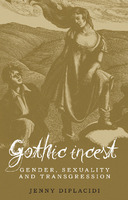Gothic incest
Gender, sexuality and transgression
Author(s)
DiPlacidi, Jenny
Collection
Knowledge Unlatched (KU)Number
100910Language
EnglishAbstract
The first full-length study of incest in the Gothic genre, this book argues that Gothic writers resisted the power structures of their society through incestuous desires. It provides interdisciplinary readings of incest within father-daughter, sibling, mother-son, cousin and uncle-niece relationships in texts by authors including Emily Brontë, Eliza Parsons, Ann Radcliffe and Eleanor Sleath. The analyses, underpinned by historical, literary and cultural contexts, reveal that the incest thematic allowed writers to explore a range of related sexual, social and legal concerns. Through representations of incest, Gothic writers modelled alternative agencies, sexualities and family structures that remain relevant today.
Keywords
Literature; gender; sexuality; Gothic literature; incest; incestuous desire; Emily Brontë; Eliza Parsons; Ann Radcliffe; Eleanor Sleath; sexualities; Gothic writers; eighteenth century; Romantic; Gothic studies; gothic tradition; Gender Studies; nineteenth century; Consanguinity; Kinship; PatriarchyDOI
10.2307/j.ctt2204rt6ISBN
9781526107558OCN
1022625501Publisher
Manchester University PressPublisher website
https://manchesteruniversitypress.co.uk/Publication date and place
Manchester, 2018-02-24Classification
Literature: history and criticism


 Download
Download